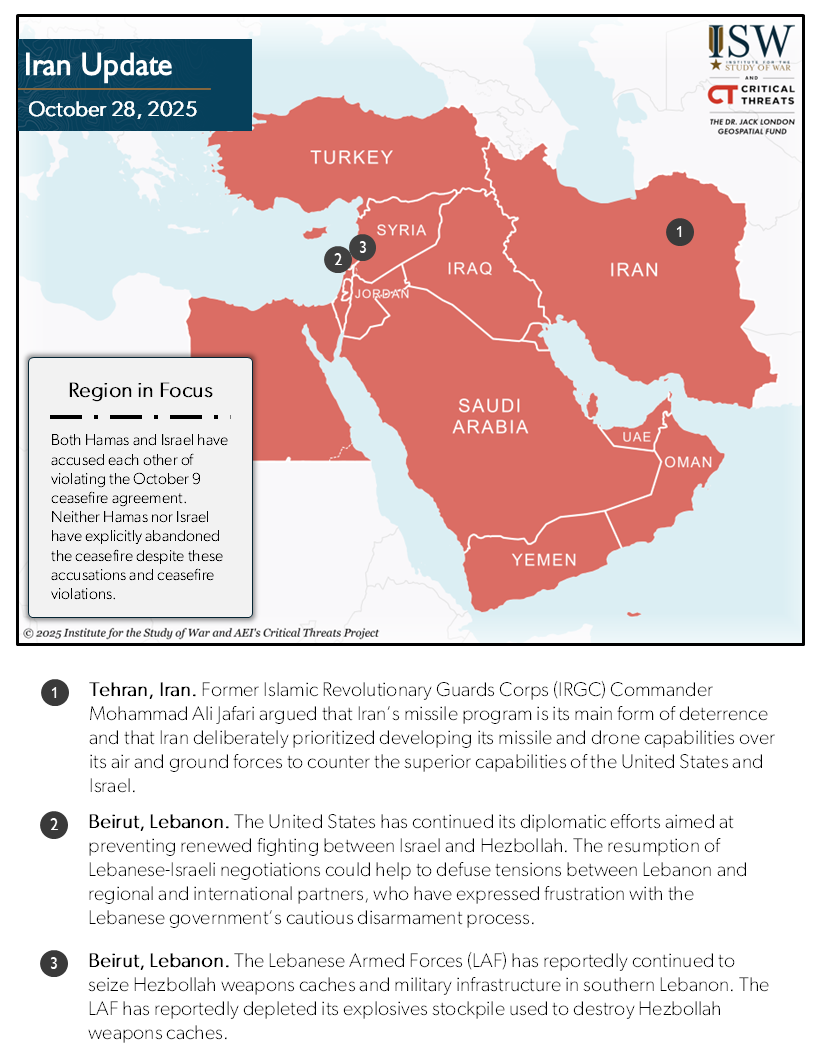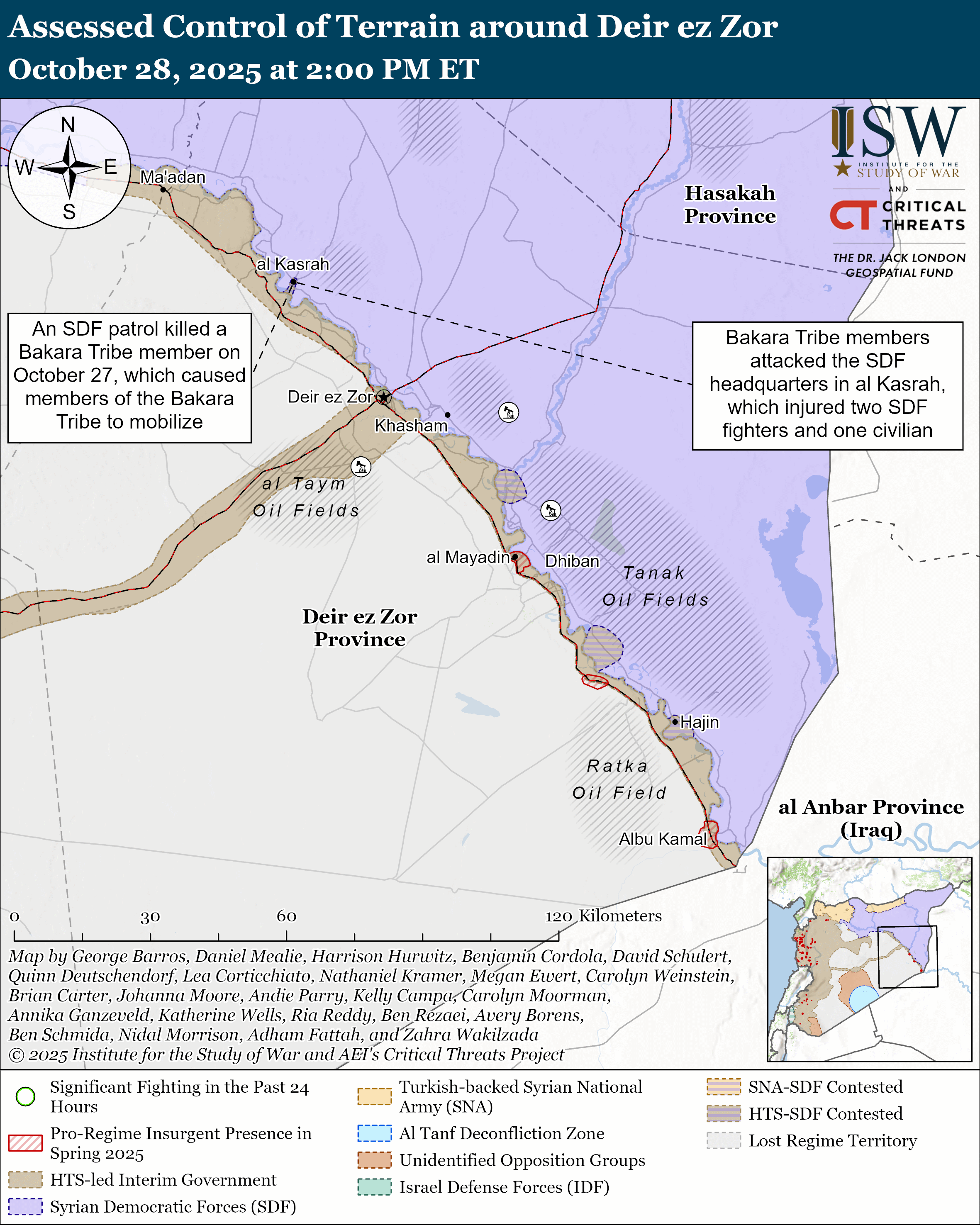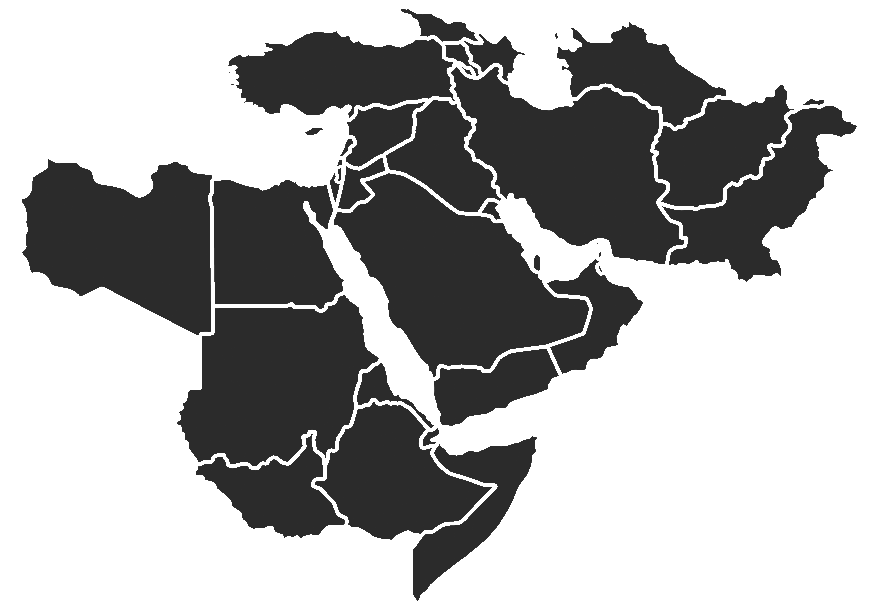{{currentView.title}}
October 28, 2025
Iran Update, October 28, 2025
Information Cutoff: 2:00 PM ET
The Critical Threats Project (CTP) at the American Enterprise Institute and the Institute for the Study of War (ISW) publish the Iran Update, which provides insights into Iranian and Iranian-sponsored activities that undermine regional stability and threaten US forces and interests. CTP-ISW publishes the Iran Update daily.
Click here to see CTP and ISW’s interactive map of assessed control of terrain in Syria, and here to see CTP and ISW’s interactive map of Israeli ground operations. The Syria map is updated daily alongside the static Syria maps in this report. CTP-ISW ended daily maps of Israeli ground operations in February 2025.
Click here to see ISW-CTP's interactive map showing the total strikes in Iran during the Israel-Iran War, as well as an interactive timelapse showing the strikes day-by-day.
Former Islamic Revolutionary Guards Corps (IRGC) Commander Mohammad Ali Jafari argued that Iran’s missile program is its main form of deterrence and that Iran deliberately prioritized developing its missile and drone capabilities over its air and ground forces to counter the superior capabilities of the United States and Israel.[i] Jafari gave an interview to the Iranian podcast “Story of the War” on October 25, which features various senior Iranian officials’ perspectives on the Israel–Iran War.[ii] Jafari provided a long summary about the development of Iranian defense strategy. Jafari stated that after a strategic review directed by Supreme Leader Ali Khamenei after the Iran-Iraq War, Iran concluded that future conflicts would differ from the war with Iraq and that Iran needed to prioritize other capabilities beyond its ground forces.[iii] Jafari added that Khamenei made the Artesh—Iran’s conventional military—responsible for air defenses and conventional air force technologies like fighter aircraft, and made the IRGC responsible for missiles and drones.[iv] Iran chose this approach to compensate for its limited conventional capabilities and to ensure that it could deter stronger adversaries through inexpensive weapons, such as missiles and drones. Jafari also stated that Iran anticipated future conflict with Israel and the United States after the Iran–Iraq War, which led it to adopt an approach focused on missiles and drones to offset the technological gap between Iranian and US airpower and information systems.[v]
Jafari also claimed that Iran has learned from its successful missile strikes to improve accuracy, starting with the 2017 strike on the Islamic State of Iraq and Syria (ISIS) in Syria, which was reportedly the first real battlefield test of Iranian missile precision.[vi] Jafari also highlighted that Iran learned from its later strikes on anti-regime targets in the Iraqi Kurdistan Region in October 2022, which demonstrated further improvements to its missile precision.[vii] Jafari’s remarks indicate how Iran has tried to develop its missile capabilities through real combat experience rather than military exercises. Some senior Iranian commanders have previously stated that Iran applied lessons learned from each round of Iran’s missile strikes on Israel, but acknowledged that the True Promise I and II operations in April and October 2024 were part of the learning process.[viii] CTP-ISW previously assessed that Iran’s inability to accurately strike military or energy infrastructure in Israel highlights the limited accuracy of its ballistic missiles, which likely led Iran to adjust tactics and warhead types to compensate for these shortcomings.[ix] Deputy Vice President for Strategic Affairs Ali Abdullah Khani urged on October 13 that Iran improve its missile guidance systems and adopt maneuverable reentry vehicles to enhance accuracy, which indicates that Iran has continued to emphasize the importance of missile accuracy after the war.[x] Khani added that Iran must reduce its missiles’ circular error probable (CEP), which is “the radius of a circle, centered at the intended target, within which 50 percent of the missiles would be expected to impact.”[xi]
Senior Iranian officials continue to threaten the closure of the Strait of Hormuz, likely aiming to deter adversaries and raise the cost of further action. Jafari stated that Iran kept some options in reserve and did not need to use them during the Israel-Iran War in response to a question about why Iran did not employ naval forces in the Persian Gulf and Strait of Hormuz.[xii] Jafari stated that Iran would likely close the Strait of Hormuz if Israel or the United States struck Iran's infrastructure, like water, electricity, or gas, to pressure civilians.[xiii] Jafari added that Iran will also employ these capabilities if a future conflict proves harder.
Iran may be able to use ballistic or cruise missiles to strike moving ships in the Straits of Hormuz and Persian Gulf in future rounds of conflict. Jafari claimed that Iran has the capabilities to strike moving ships. The Houthis, who use Iranian technology and have received Iranian training, have managed to hit multiple moving ships. Iranian state media outlet Mehr News previously reported on October 7 that Iran has developed new anti-ship cruise missiles equipped with fully automated guidance systems.[xiv]

Key Takeaways
- Iran Defense Strategy: Former Islamic Revolutionary Guards Corps (IRGC) Commander Mohammad Ali Jafari argued that Iran’s missile program is its main form of deterrence and that Iran deliberately prioritized developing its missile and drone capabilities over its air and ground forces to counter the superior capabilities of the United States and Israel.
- Lebanese-Israeli Relations: The United States has continued its diplomatic efforts aimed at preventing renewed fighting between Israel and Hezbollah. The resumption of Lebanese-Israeli negotiations could help to defuse tensions between Lebanon and regional and international partners, who have expressed frustration with the Lebanese government’s cautious disarmament process.
- Hezbollah Disarmament: The Lebanese Armed Forces (LAF) has reportedly continued to seize Hezbollah weapons caches and military infrastructure in southern Lebanon. The LAF has reportedly depleted its explosives stockpile used to destroy Hezbollah weapons caches.
Iran
Iran sees the development of new economic corridors as a key element of regional economic competition. Supreme Leader Military Affairs Adviser Major General Seyed Yahya Safavi stated on October 27 that the world is engaged in a new era of competition called the “war of corridors,” determined by railway lines, sea routes, and transit roads.[xv] He added that Iran is a key player because of its unique geographical location and due to Sistan and Baluchistan Province's position at the center of the “war of corridors“ competition. Iran is a member of the International North-South Transport Corridor (INSTC), which it seeks to use to strengthen its economic relations with regional states. The INSTC is a trade route that connects India, Iran, Russia, and Central Asia via road, rail, and sea to reduce the transit time and costs between South Asia and Europe.[xvi] Iran has recently strengthened its economic ties with Pakistan, which borders Sistan and Baluchistan Province. Iran’s Roads and Urban Development Minister Farzaneh Sadegh met with Pakistani Federal Minister for Communications Abdul Aleem Khan, Federal Minister for Railways Hanif Abbasi, and Federal Minister for Commerce Jam Kamal Khan in recent weeks to discuss the establishment of a joint committee to resolve cross-border trade issues and the recent Pakistan-Iran railway agreement.[xvii] Abbasi proposed expediting the implementation of a Pakistan-Iran rail agreement that was signed in September and announced that the Islamabad-Tehran-Istanbul Train Project will be reviewed in December. Khan emphasized Pakistan’s desire to enhance the bilateral trade volume with Iran to $10 billion, while Sadegh expressed Iran’s interest in increasing maritime cooperation through Chabahar and Gwadar ports.
Iraq
Nothing significant to report.
Syria
The Syrian Democratic Forces (SDF)’s lack of discipline in the Arab majority areas of Deir ez Zor Province has continued to cause Arab tribes to mobilize against the SDF. An SDF patrol killed a Bakara Tribe member in al Kasrah, Deir ez Zor Province, on October 27 when the tribesman attempted to overtake the SDF patrol in his car.[xviii] Local sources told Syrian media on October 27 that the SDF patrol commander shot the young man in the head while he was driving, which caused the vehicle to crash, and then the commander shot him again.[xix] Bakara tribespeople attacked the SDF headquarters in al Kasrah on October 27 in response to the killing, and injured two SDF members and one civilian during the attack.[xx] The SDF apologized on October 28 for the tribesman’s death and said that his death was an accident.[xxi] The SDF also arrested the SDF members involved in the incident.[xxii] The SDF’s lack of force discipline in Deir ez Zor Province has previously caused Arab tribes to mobilize against the SDF. The Arab al Shaytat clan mobilized against the SDF in September 2025 after SDF forces reportedly killed an unarmed civilian in Gharanij, Deir ez Zor Province.[xxiii] The SDF reportedly refused to return the civilian’s body to his family, prompting the Gharanij mosque to call for “jihad and general mobilization.”[xxiv]
Arab tribal mobilization against the SDF in Deir ez Zor Province is more concerning for the SDF now than it has been in previous years because of the fall of Assad. The new Shara-led, predominantly Sunni Arab government that opposed Assad is an attractive alternative to SDF rule. Arab tribes in Deir ez Zor have intermittently risen up against the SDF for a variety of reasons. The SDF’s undisciplined and sometimes overzealous counterinsurgent forces and criminal actions by some SDF commanders have alienated some locals. A local Arab SDF commander in Deir ez Zor brutally murdered two Bakara tribeswomen in 2023, for example, which sparked Bakara-led protests and fighting between the SDF and local Arabs, including Bakara tribesmen.[xxv] The Assad regime’s control over most of Syria until December 2024 discouraged Arab tribes in Deir ez Zor Province from mobilization against the SDF because allegiance and integration into the Assad regime or a resurgent ISIS was a worse alternative to SDF rule. The changes since late 2024 mean that the tribal mobilization is more concerning because the tribes have a viable alternative. The SDF will need to commit more forces to control Arab areas in the event of a Turkish incursion under these circumstances, because some Arab tribes could seek to reintegrate with the remainder of Syria.

Arabian Peninsula
Nothing significant to report.
Palestinian Territories and Lebanon
Both Hamas and Israel have accused each other of violating the October 9 ceasefire agreement. Neither Hamas nor Israel has explicitly abandoned the ceasefire despite these accusations and ceasefire violations. Hamas and Israel agreed to a ceasefire and hostage-prisoner exchange on October 9.[xxvi] A spokesperson for Israeli Prime Minister Benjamin Netanyahu stated on October 28 that Hamas violated the ceasefire by “not returning hostages and attacking our forces.”[xxvii] Netanyahu ordered the Israel Defense Forces on October 28 to immediately carry out ”forceful strikes” in the Gaza Strip following ”security consultations.”[xxviii] Hamas announced that it postponed the handover of the body of a deceased hostage in response to the Israeli strikes.[xxix] Hamas Political Bureau member Suhail al Hindi stated on October 28 that Hamas has ”no interest” in concealing any hostage’s body or delaying the handover of deceased hostages.[xxx] Hindi reaffirmed Hamas’ full commitment to the ceasefire agreement.[xxxi]
The United States has continued its diplomatic efforts aimed at preventing renewed fighting between Israel and Hezbollah. US Deputy Special Envoy for the Middle East Morgan Ortagus met with Lebanese President Joseph Aoun on October 28 to discuss activating the ceasefire monitoring committee.[xxxii] Aoun called on Ortagus and the United States to support the return of southern Lebanese civilians and Lebanon’s reconstruction, and to pressure Israel to halt its operations in Lebanon.[xxxiii] Ortagus met with Parliament Speaker and Hezbollah ally Nabih Berri on October 28 to discuss the monitoring committee and ongoing Israeli operations in Lebanon.[xxxiv] Lebanese media reported that Ortagus proposed to Berri two choices: direct talks with Israel or indirect negotiations through the monitoring committee.[xxxv] Aoun previously rejected direct negotiations and instead suggested indirect talks with Israel to resolve outstanding issues on the US proposal to disarm Hezbollah.[xxxvi] Lebanese officials have similarly called for indirect negotiations with Israel, under the auspices of the monitoring committee, to resolve outstanding issues.[xxxvii] The resumption of negotiations could help to defuse tensions between Lebanon and regional and international partners, who have expressed frustration with the Lebanese government’s cautious disarmament process.[xxxviii] Ortagus’s meetings also come amid concerns and warnings of an imminent Israeli escalation in Lebanon. Lebanese media reported on October 23 that Hezbollah is expecting an imminent Israeli escalation.[xxxix] US and European officials warned on October 20 and 24, respectively, about the possibility of a large-scale Israeli operation targeting Hezbollah.[xl]
The Lebanese Armed Forces (LAF) has reportedly continued to seize Hezbollah weapons caches and military infrastructure in southern Lebanon. An unspecified security source and a Lebanese official told Reuters on October 28 that the LAF has increased its rate of operations to uncover Hezbollah weapons caches in southern Lebanon.[xli] Two additional unspecified informed sources reported that the LAF discovered nine new Hezbollah weapons caches in September and sealed off access to “dozens” of Hezbollah tunnels.[xlii] Senior Lebanese officials reported that the LAF is on track to complete its disarmament operations in southern Lebanon by the end of the year.[xliii] CTP-ISW has not observed any reports that the LAF has seized arms from Hezbollah fighters or raided any active Hezbollah sites with Hezbollah personnel present, which would be critical to fully disarming Hezbollah south of the Litani River.
The LAF has reportedly depleted its explosives stockpile used to destroy Hezbollah weapons caches. A security source and one Lebanese official told Reuters that the LAF ran out of explosives in June 2025 due to the number of Hezbollah weapons caches it seized and destroyed in southern Lebanon.[xliv] The United States approved a $14.2 million USD aid package to the LAF on September 10, which will include explosives for disarmament operations.[xlv] The LAF has reportedly “seal[ed] off” access to seized Hezbollah weapons caches and infrastructure until the United States replenishes the LAF’s explosive stockpile to destroy Hezbollah's capabilities.[xlvi] US military aid and explosives could reportedly take months to arrive in Lebanon, according to an unspecified source “familiar with the process,” however.[xlvii]

[i] https://www.kebnanews dot ir/news/505392
[ii] https://www.youtube.com/watch?v=trj_0JJkl3g
[iii] https://www.kebnanews dot ir/news/505392
[iv] https://www.youtube.com/watch?v=trj_0JJkl3g
[v] https://www.kebnanews dot ir/news/505392
[vi] https://www.kebnanews dot ir/news/505392
[vii] https://www.kebnanews dot ir/news/505392
[viii] https://understandingwar.org/research/middle-east/iran-update-october-16-2025/ ;
https://understandingwar.org/research/middle-east/iran-update-october-21-2025/ ;
https://fararu dot com/fa/news/917377/
[ix] https://understandingwar.org/research/middle-east/iran-update-special-report-june-24-2025-evening-edition/
[x] https://nournews dot ir/fa/news/250551 ;
https://understandingwar.org/research/middle-east/iran-update-october-20-2025/
[xi] https://digitalcommons.usu.edu/etd/6805/#:~:text=The%20Department%20of%20Defense%20has%20places%20emphasis,or%20%22The%20probability%20is%200.50%20that%20an
[xii] https://www.kebnanews dot ir/news/505392
[xiii] https://www.kebnanews dot ir/news/505392
[xiv] https://www.mehrnews dot com/news/6613177
[xv] http://nournews dot ir/fa/news/253438 ; https://www.isna dot ir/news/1404080502935
[xvi] https://www.tasnimnews dot com/fa/news/1404/03/06/3322736 ; https://www.tasnimnews dot com/fa/news/1404/07/23/3424466
[xvii] https://tribune dot com.pk/story/2574222/pak-iran-panel-to-resolve-border-issues
[xviii] https://www.enabbaladi dot net/780740/%d8%a7%d8%b4%d8%aa%d8%a8%d8%a7%d9%83%d8%a7%d8%aa-%d9%81%d9%8a-%d8%af%d9%8a%d8%b1-%d8%a7%d9%84%d8%b2%d9%88%d8%b1-%d8%a8%d8%b9%d8%af-%d9%85%d9%82%d8%aa%d9%84-%d8%b4%d8%a7%d8%a8-%d8%b9%d9%84%d9%89-%d9%8a/
[xix] https://www.enabbaladi dot net/780740/%d8%a7%d8%b4%d8%aa%d8%a8%d8%a7%d9%83%d8%a7%d8%aa-%d9%81%d9%8a-%d8%af%d9%8a%d8%b1-%d8%a7%d9%84%d8%b2%d9%88%d8%b1-%d8%a8%d8%b9%d8%af-%d9%85%d9%82%d8%aa%d9%84-%d8%b4%d8%a7%d8%a8-%d8%b9%d9%84%d9%89-%d9%8a/
[xx] https://www.enabbaladi dot net/780740/%d8%a7%d8%b4%d8%aa%d8%a8%d8%a7%d9%83%d8%a7%d8%aa-%d9%81%d9%8a-%d8%af%d9%8a%d8%b1-%d8%a7%d9%84%d8%b2%d9%88%d8%b1-%d8%a8%d8%b9%d8%af-%d9%85%d9%82%d8%aa%d9%84-%d8%b4%d8%a7%d8%a8-%d8%b9%d9%84%d9%89-%d9%8a/ ; https://www.facebook.com/share/p/1A49EcJQxA/
[xxi] https://sdf-press dot com/archives/46975
[xxii] https://sdf-press dot com/archives/46975
[xxiii] https://www.enabbaladi dot net/773501/%D8%B9%D8%B4%D9%8A%D8%B1%D8%A9-%D8%AA%D8%B9%D9%84%D9%86-%D8%A7%D9%84%D9%86%D9%81%D9%8A%D8%B1-%D8%B6%D8%AF-%D9%82%D8%B3%D8%AF-%D8%A8%D8%B9%D8%AF-%D9%82%D8%AA%D9%84-%D8%B4%D8%A7%D8%A8-%D9%88%D8%AD/# ; https://understandingwar.org/research/middle-east/iran-update-september-12-2025/
[xxiv] https://www.enabbaladi dot net/773501/%D8%B9%D8%B4%D9%8A%D8%B1%D8%A9-%D8%AA%D8%B9%D9%84%D9%86-%D8%A7%D9%84%D9%86%D9%81%D9%8A%D8%B1-%D8%B6%D8%AF-%D9%82%D8%B3%D8%AF-%D8%A8%D8%B9%D8%AF-%D9%82%D8%AA%D9%84-%D8%B4%D8%A7%D8%A8-%D9%88%D8%AD/# ; https://understandingwar.org/research/middle-east/iran-update-september-12-2025/
[xxv] https://rojavainformationcenter dot org/2023/08/deir-ez-zor-explainer/
[xxvi] https://www.bbc.com/news/articles/cvgqx7ygq41o
[xxvii] https://www.nytimes.com/2025/10/28/world/middleeast/israel-gaza-netanyahu-strikes.html?smid=nytcore-ios-share&referringSource=articleShare
[xxviii] https://x.com/IsraeliPM/status/1983207505883803934
[xxix] https://t.me/QudsN/631868
[xxx] https://t.me/QudsN/631851
[xxxi] https://t.me/QudsN/631851
[xxxii] https://www.naharnet dot com/stories/en/316123-ortagus-meets-aoun-and-berri-reportedly-proposes-indirect-talks-involving-civilians ; https://x.com/LBpresidency/status/1983118948238602317
[xxxiii] https://www.naharnet dot com/stories/en/316123-ortagus-meets-aoun-and-berri-reportedly-proposes-indirect-talks-involving-civilians
[xxxiv] https://www.naharnet dot com/stories/en/316123-ortagus-meets-aoun-and-berri-reportedly-proposes-indirect-talks-involving-civilians
[xxxv] https://www.naharnet dot com/stories/en/316123-ortagus-meets-aoun-and-berri-reportedly-proposes-indirect-talks-involving-civilians
[xxxvi] https://www.naharnet dot com/stories/en/315902-reports-aoun-receives-message-calling-for-direct-talks-with-israel
[xxxvii] https://x.com/ALJADEEDNEWS/status/1979596075049582691
[xxxviii] https://today.lorientlejour dot com/article/1481725/international-donors-conferences-for-lebanon-on-track-france-waits-for-riyadh.html
[xxxix] https://addiyar dot com/article/2275090-البقاع-الشمالي-والغربي-امام-احتمال-تصعيدعيد-إسرائيلي-خطرزامير-يدق-طبول-الحرب-وسط
[xl] https://x.com/NidaaWatan/status/1981615956502688194 ; https://x.com/USAMBTurkiye/status/1980139041724190877
[xli] https://www.reuters.com/world/middle-east/lebanese-army-walks-political-tightrope-disarm-hezbollah-2025-10-28/
[xlii] https://www.reuters.com/world/middle-east/lebanese-army-walks-political-tightrope-disarm-hezbollah-2025-10-28/
[xliii] https://www.reuters.com/world/middle-east/lebanese-army-walks-political-tightrope-disarm-hezbollah-2025-10-28/; https://x.com/AFPar/status/1965373324982436301?ref_src=twsrc%5Etfw%7Ctwcamp%5Etweetembed%7Ctwterm%5E1965373324982436301%7Ctwgr%5E0dff2be17c0ff1cb431e64d70845fea3408882ec%7Ctwcon%5Es1_&ref_url=https%3A%2F%2Fwww.al-akhbar.com%2Flebanon%2F858478%2FD8B1D8ACD98AE28093D8AED8B7D8A9-D8A7D984D8ACD98AD8B4-D8AAD982D8B6D98A-D8A8D8ADD8B5D8B1-D8A7D984D8B3D984D8A7D8AD-D8ACD986D988D8A8-D8A7D984D984D98AD8B7D8A7D986D98A-D8AED984D8A7D984-3-D8A3D8B4D987D8B1
[xliv] https://www.reuters.com/world/middle-east/lebanese-army-walks-political-tightrope-disarm-hezbollah-2025-10-28/
[xlv] https://www.war.gov/News/Releases/Release/Article/4300023/trump-administration-announces-security-assistance-package-for-lebanon/
[xlvi] https://www.reuters.com/world/middle-east/lebanese-army-walks-political-tightrope-disarm-hezbollah-2025-10-28/
[xlvii] https://www.reuters.com/world/middle-east/lebanese-army-walks-political-tightrope-disarm-hezbollah-2025-10-28/
